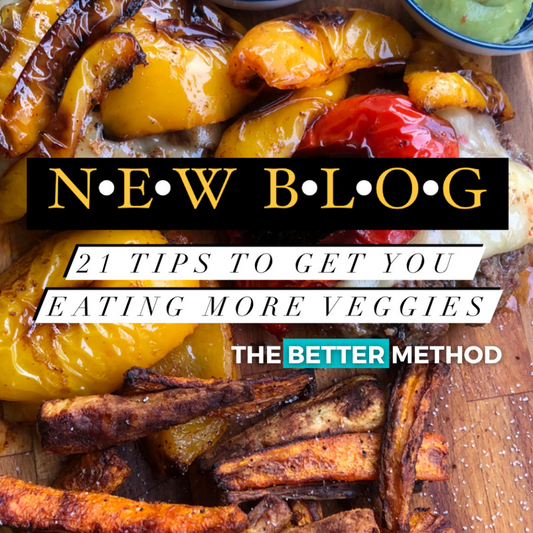How confident do you feel about cooking animal protein at home? For a very few, 10/10 confident. For many more, not so confident. Not surprisingly, no skill = no will, which means no motivation to cook it at home and a low daily protein intake at the same time. In today’s blog, we bring together two important topics that have helped our clients see improved results: food prep and protein to provide you with some helpful tips to get you excited about preparing your own meals and improving your protein intake.
The importance of protein goes beyond being the building blocks of your muscle. It helps you to: maintain a healthy weight, prevent over-eating, improve recovery from exercise or injury, boost metabolism and more!
Now, the benefits of preparing your food are invaluable! Once clients know how much it impacts them and their results, they willingly carve time out of their busy schedules to get to the grocery store and prepare (even some of) their own meals! Here’s a taste of some benefits of preparing homemade meals:
- Know everything that goes into your meals. No sneaky hidden oils or additives that are hard to pronounce that you might find in meals already prepared for you. You know these hidden ingredients can throw off your fitness progress, right?
- Adjust portion sizes. How many times would you eat out and think, “Where’s the rest of my protein?” Not the case when you eat at home!
- Make meals personal to your preference: saltiness, flavour, texture, temperature. Anyway you want it!
- Practice and refine life skills! Don’t forget that cooking is a skill which means it can be improved. Like exercise, the more you do it, the more opportunity to have to get better at it!
- Save money! Those meals out are already adding to your waistline, don’t let them add to your expenses, too!
- Avoid getting hangry! How many times have you gotten really hangry, like cleared-the-room hangry, because you got so busy at work that you couldn’t step out to grab a meal? When your colleagues and friends can tell that you’re due for a meal, you’ve been hangry too often. Food on hand = hanger gone! Magic.
- Gain satisfaction knowing you are cooking for yourself (and possibly your household).
Beyond only controlling what goes into your body, you really take ownership of your health and lifestyle by preparing your own meals. This gives you more empowerment to take ownership of other areas of your life, too.
Ok, let’s get to the meat of it!
Tips for Protein Prep at Home
1. Wet brine meat before cooking. Brine is a mixture of water and salt that you soak meat in before cooking. This helps add flavour to your meat and physically changes your meat so that it holds more moisture when you cook it. Most meats can be brined: chicken, pork, roasts, fish, turkey, and beef. Brine for about 30 minutes to 1 hour for each pound of meat up to 24 hours. Over-brining can lead to proteins that are far too broken down (try to avoid this!). For salt to water ratio, use 1 tablespoon of salt for each cup of water. You can use the brine mixture as a vehicle for flavour and add smashed garlic and whole spices. Make sure to submerge all of the meat in the brine in the fridge. Important: rinse your meat off in water and discard the brine! Do not cook with the brine.
2. Cook meat from room temperature. Take your meat out an hour or so before you’re ready to cook it. If you’re trying to cook meat to an internal temperature, it takes less time to get to that temperature if you start it at a higher temperature. This means the meat spends less time cooking. When you are cooking, you are dehydrating the meat, so less time (to safe temperature) means less dehydration = juicier cuts of meat!
3. Dry meat before searing. Dabbing your meat dry with some paper towel before searing creates a better sear. Dry meat on a hot pan allows for something called the Maillard Reaction. This is a process where meat is browned. In an environment where there is too much water present, you will end up steaming your meat instead of searing it. Searing it will lock in juices, give you depth of flavour and make you feel like a badass chef!
4. How to Sear Meat - A few key details to ensure a nice sear:

5. Cook meat to temperature. Different types of meat (as well as how they are processed), required different cooking temperatures to be considered safe. Usually ground meats require a higher final cooking temperature compared to steaks. As well, poultry and pork are recommended to be cooked through while steaks of red meat and fish generally can be eaten safely without being fully cooked. Use this Safe Cooking Temperatures chart to see what temperatures your meats should be cooked to for safe consumption!
5.1. Get a meat thermometer. Nothing dries out meat more than constantly cutting through it to see if it’s cooked! Since it’s not rested (see next point), you lose a lot of the juices. Also, the main reason is safety. You can guess if it’s cooked but as a start to building your confidence, I would suggest this tool. A basic one which will cost you roughly $8-12 dollars on Amazon or your local grocery store and save you frustration and from eating really dry meat when you craved something succulent!
6. Rest meat after cooking. Let’s be real: You’ll be tempted to cut right into your perfectly seared meat after your first brine. But don’t do it! Recipes call for internal temperature on meat with the assumption that you continue to let it rest. Your delectable cuts still rise in temperature while they rest. Not only that, when meat is cooking, the muscle fibers constrict bringing the juices away from the hot surfaces and towards the center of the meat. While resting, the muscle fibers relax which redistributes the juices throughout the meat! Transfer your meat to a cutting board and lay a loose layer of foil over top. Rest meat for roughly 5-7 minutes for single portion sized meats and roughly 10 minutes for every pound when cooking whole birds or large roasts.
7. Cook meat based on cut. While less tender cuts of meat require moist heat cooking methods to help break down the connective tissues (collagen) over a long period, more tender parts with little connective tissue can handle high dry heath. You have to determine if the cut requires just long enough to make it safe and tasty to eat or is it a mostly tough cut that requires breaking down the connective tissues. Typically, more tender parts are from the areas of the animal that have little activity (ribs and back) and the areas that get more exercise (legs, shoulders, chest, neck) have more connective tissues and need more cooking time. For beef, here are the general low and slow vs high and fast cuts:
8. Sear meat first before cooking it in moisture. Even if you are pressure or slow cooking meats such as stewing beef or English cut short ribs, take your “low and slow” cuts to a hot pan first to help lock in the juices as well as creating that depth of flavour. Doing this allows you to do the next tip:
9. Deglaze the pan! Deglazing is the process where you remove meat or veggies that you just seared from a pan, and then use a liquid to remove the tasty, caramelized brown bits from the pan. Doing this allows you to collect all of the flavour from the pan and use this to add into the moisture heating or a sauce. Don’t waste these flavour bits!
10. Slice meat across the grain, not along it. For roasts, steaks, chicken or turkey breast cut your meat against the grain. Your meat dramatically feels more tender this way. Even if your meat comes out a little drier than you prefer, make it easy to eat by slicing it across the grain. The grain refers to the line of the muscle fibers. If you cut along the fibers, the meat can be harder to chew because you are chewing long strings of muscle. If you cut against the grain, you cut the long fibers down leaving each bite easy to eat, regardless of how well you made it! It’s much easier to separate the muscle fibers from each other than chewing down long fibers.


11. Try different proteins and different ways of cooking them! You might find different low and slow cuts different from slow cooker to oven or you prefer different fast and hot cuts on the grills vs a skillet. Don’t be afraid of experimenting!
12. Use online recipes to get inspiration! The best part is that someone has already figured out all the details through trial and error so you don’t. Check the comments for helpful tips that people have left. This will give you some options and inspire you to keep trying.
There you have it! A tip for every step of the preparation process once you get your meats into your home. Like everything else that you take on that’s new, be patient with yourself. Have fun in the process and don’t be discouraged by a few kitchen blips. The more reps you get in, the better the reps get. Be proud of your meals and feel free to post on your social media and tag us @the.better.method once you’ve tried a tip or two.
We would love to hear any protein prep tips that you stand by to keep you consistent so please share in the comments below!




